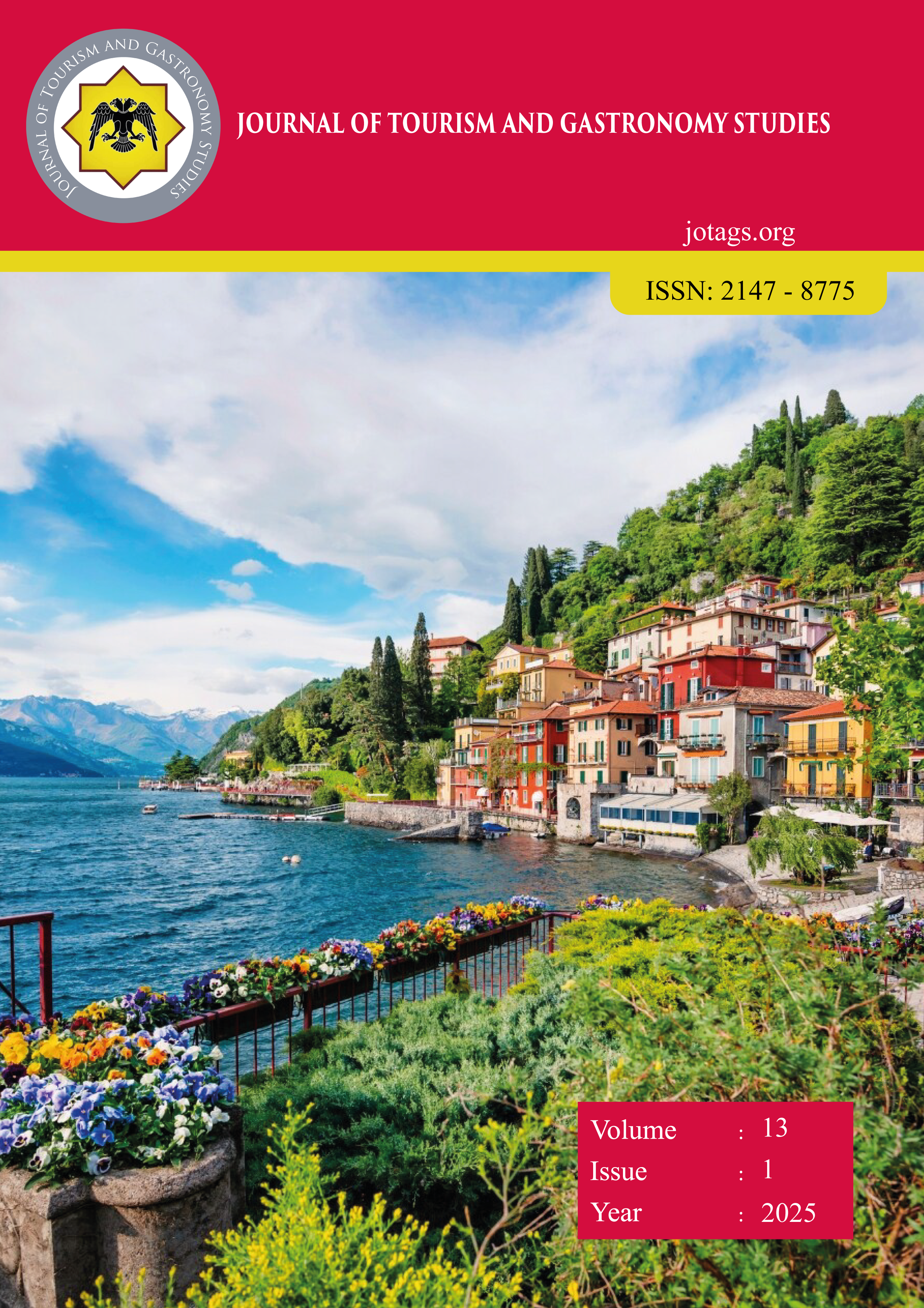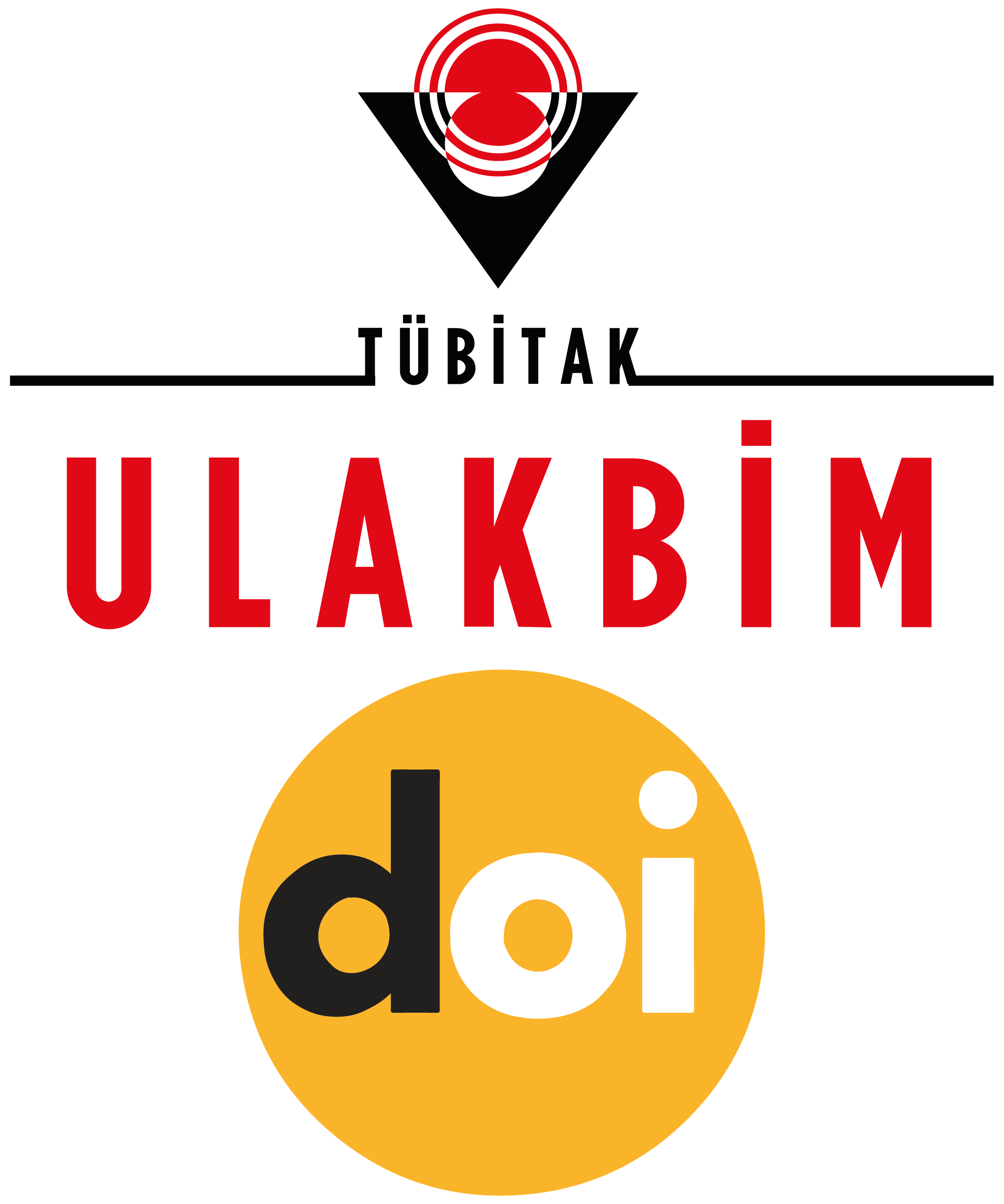Avrupa Birliğinde Coğrafi İşaretler ve Türkiye’nin Mevcut Durumu (Geographical Indications in The European Union and the Current Situation of Turkey)
DOI:
https://doi.org/10.21325/jotags.2025.1572Keywords:
Tourism, Geographical indication, EU Geographical indicationsAbstract
Geographically indicated products play a critical role in the protection of local cultural heritage, as well as making significant contributions to regional economic development, acting as an effective tool in the promotion of destinations, creating a touristic attraction and ensuring the protection of the rights of both producers and consumers. The main purpose of this study is to determine the international level of geographically indicated products in the European Union and to evaluate Turkey's current situation in this regard. For this purpose, the data obtained from the eAmbrosia database was analyzed using the content analysis method. Geographically indicated products were classified and explained according to countries, product groups and types of geographical indications, and similarly, the current situation in Turkey was presented. As a result of the research, it was determined that a total of 3909 applications have been made to the EU to date, 91% of which were made by EU member states, the country that made the most applications was Italy, 48% of the total applications were food, 44% were wine, 8% were alcoholic beverages, Turkey had a total of 85 applications and 23 products with registered geographical indications, and Turkey constituted 2% of the total geographical applications.
References
Alparslan, Ö. S., & Demirbaş, N. (2019). Avrupa Birliği ve Türkiye’de bal üretim ve ticareti açısından coğrafi işaret uygulamalarının değerlendirilmesi. Yüzüncü Yıl Üniversitesi Tarım Bilimleri Dergisi, 29(3), 526-538. doi:10.29133/yyutbd.547413
Altunışık, R., Coşkun, R., Bayraktaroğlu, S., & Yıldırım, E. (2012). Sosyal Bilimlerde Araştırma Yöntemleri SPSS Uygulamalı. Sakarya: Sakarya Kitabevi
Borg, E. A. (2013). Collective brand strategy, entrepreneurship, and regional growth: the role of a Protected Designation of Origin (PDO). Journal of World Economic Research, 2, 26-38. https://doi.org/10.11648/j.jwer.20130203.11
Bowen, S., & Zapata, A. V. (2009). Geographical indications, terroir, and socioeconomic and ecological sustainability: The case of tequila. Journal of Rural Studies, 25(1), 108-119. https://doi.org/10.1016/j.jrurstud.2008.07.003
Bredahl, L. (2001). Determinants of consumer attitudes and purchase intentions with regard to genetically modified foods: results of a cross-national survey. Journal of Consumer Policy, 24, 23-61. https://doi.org/10.1023/A:1010950406128
Chilla, T., Fink, B., Balling, R., Reitmeier, S., & Schober, K. (2020). The EU food label protected geographical indication: Economic implications and their spatial dimension. Sustainability, 12, 5503. https://doi.org/10.3390/su12145503
Commission, E. (2019). Study on economic value of EU quality schemes, geographical indications (GI) and traditional specialities guaranteed (TSG). Brussels: European Commission.
Çekiç, İ., Bulut, Z., & Oğan, Y. (2023). Coğrafi işaretli ürünlere ilişkin yerli turist tutumları üzerine bir inceleme, Artvin Çoruh Üniversitesi Uluslararası Sosyal Bilimler Dergisi, 9(1), 242-255. https://doi.org/10.22466/acuusbd.1296449
Dafni, Z. L. F. (2023). Greek consumers attitudes and motivations against PDO/PGI Agrifoods. Brazilian Journal of Science, 2(9), 76-86. https://doi.org/10.14295/bjs.v2i9.367
Diana Farinha, H. F., Nunes, C., & Hélia Sales, R. P. (2023). Bioactive compounds of Portuguese fruits with PDO and PGI. Foods, 12, 2-26. doi.org/10.3390/foods12162994
Dias, C., & Mendes, L. (2018). Protected Designation of Origin (PDO), Protected Geographical Indication (PGI) and Traditional Speciality Guaranteed (TSG): A bibiliometric analysis. Food Research International, 103, 492-508. https://doi.org/10.1016/j.foodres.2017.09.059
Doğan, B. (2015). Coğrafi işaret korumasının gelişmekte olan ülkeler için önemi. NWSA-Social Sciences, 10(2), 58-75.
Dora, M., Kumar, M., Goubergen, D. V., Molnar, A., & Gellynck, X. (2013). Operational performance and critical success factors of lean manufacturing in European food processing SME. Trends in Food Science and Technology, 31(2), 156-164. doi: 10.1016/j.tifs.2013.03.002.
EAmbrosia (2024, 07. 29). https://ec.europa.eu/agriculture/eambrosia/geographical-indications-register/
Europan Commission. (2024, 07 29). https://agriculture.ec.europa.eu/farming/geographical-indications-and-quality-schemes/geographical-indications-and-quality-schemes-explained_en
Europena Commission. (2024, 07 29). https://agriculture.ec.europa.eu/news/protecting-local-food-and-drinks-3-500-geographical-indications-registered-2023-02-23_en
FAO. (2019). Geographical Indications for sustainable food systems. Preserving and promoting agricultural and food heritage. Food and Agriculture Organization of the United Nations.
FAO. (2024, 07 29). FAO. Food and Agriculture Organization of the United Nations: http://www.fao.org/3/ca5693en/ca5693en.pdf
Fernández-Ferrín, P., Bande, B., Galán-Ladero, M. M., Martín-Consuegra, D., Díaz, E., & Castro-González, S. (2019). Geographical indication food products and ethnocentric tendencies: The importance of proximity, tradition, and ethnicity. Journal of Cleaner Production, 241(20), 118-210. https://doi.org/10.1016/j.jclepro.2019.118210
Fotopoulos, C., & Krystallis, A. (2003). Quality labels as a marketing advantage: The case of the “PDO Zagora” apples in the Greek market. European Journal of Marketing, 37, 1350-1374. https://doi.org/10.1108/03090560310487149
Grunert, K. G., & Aachmann, K. (2016). Consumer reactions to the use of EU quality labels on food products: A review of the literature. Food Control, 59, 178-187. https://doi.org/10.1016/j.foodcont.2015.05.021
Hajdukiewicz, A. (2014). European Union agri-food quality schemes for the protection and promotion of geographical indications and traditional specialities: an economic perspective. Folia Horticulturae, 26(1), 3-17. https://doi.org/10.2478/fhort-2014-0001
Herrera, C. F. (2011). Consequences of consumer trust in PDO food products: the role of familiarity. Journal of Product and Brand Management, 20, 282-296. https://doi.org/10.1108/10610421111148306
Iotti, M., Ferri, G., & Bonazzi, F. (2024). Financial ratios, credit risk and business strategy: Application to the PDO Parma ham sector in single production and non-single production firms. Journal of Agriculture and Food Research, 16, 101-122. https://doi.org/10.1016/j.jafr.2024.101122
Karademir, N. (2021). Türkiye'de Avrupa Birliği tescilli coğrafi işaretli ürünlerin ekonomik kalkınma kapsamında değerlendirilmesi. Journal of Social, Humanities and Administrative Sciences, 7(41), 1164-1183. http://dx.doi.org/10.31589/JOSHAS.664
Krippendorff, K. (1980). Content Analysis: An Introduction to is Methodology, Sage, Beverly Hills.
Marie-Vivien, D., & Biénabe, E. (2017). The Multifaceted Role of the State in the Protection of Geographical Indications: A Worldwide Review. World Development, 98, 1-11. https://doi.org/10.1016/j.worlddev.2017.04.035
Marsden, T. B. (2000). Food supply chain approaches: exploring their role in rural development. Sociologia Ruralis, 40(4), 424-438.
Menozzi, D., Giraud, G., Saïdi, M., & Yeh, C.-H. (2021). Choice drivers for quality-labelled food: A cross-cultural comparison on PDO cheese. Foods, 10, 2-17. doi.org/10.3390/foods10061176
Mevzuat.gov.tr. (2024, 07 29). https://www.mevzuat.gov.tr/mevzuatmetin/1.5.6769.pdf
Murdoch, J. M. (2000). Quality, nature, and embeddedness: Some theoretical considerations in the context of the food sector. Economic Geography, 76, 107-125.
Olgun, F. A., & Sevilmiş, G. (2017). Uluslararası düzeyde coğrafi işaretler, yaratılan ekonomik değer ve türkiye'deki sistemin değerlendirilmesi. Turkish Journal of Agricultural Economics, 23(2), 205-213. doi:10.24181/tarekoder.364953
Parrott, N., Wilson, N., & Murdoch, J. (2002). Spatializing quality: regional protection and the alternative geography of food. European Urban and Regional Studies, 9(3), 241-261. https://doi.org/10.1177/096977640200900304
Renting, H. M. (2003). Understanding alternative food networks: exploring the role of short food supply chains in rural development. Environment and planning A, 35(3), 393-411.
Savelli, E., Bravi, L., Francioni, B., Murmura, F., & Pencarelli, T. (2021). PDO labels and food preferences: results from a sensory analysis. British Food Journal, 123(3), 1170-1189. doi:10.1108/BFJ-05-2020-0435
Southey, F. (2024, 07 29). Food Navigator: https://www.foodnavigator.com/Article/2020/04/22/ Geographical-Indications-worth-a-mouth-watering-75-billion-study
Stein, A. J., & Santini, F. (2022). The sustainability of “local” food: a review for policy-makers. Review of Agricultural, Food and Environmental Studies, 103, 77-89. https://doi.org/10.1007/s41130-021-00148-w
Török, Á., Jantyik, L., Maró, Z. M., & Moir, H. V. (2020). Understanding the real-world ımpact of geographical ındications: a critical review of the empirical economic literature. Sustainability, 12, 2-24.
Türk Patent ve Marka Kurumu. (2021). Türk Patent ve Marka Kurumu: https://ci.turkpatent.gov.tr/uploads/files/CI_AB_Tescil_Egitim_Seti_kitapcik.pdf
Van der Ploeg, J. D. (2000). Rural development: from practices and policies towards theory. Sociologia Ruralis, 40, 391-408. https://doi.org/10.1111/1467-9523.00156
Vecchio, R. &. (2011). The role of PDO/PGI labelling in Italian consumers’ food choices. Agricultural Economics Review, 12, 80-98.
Downloads
Published
How to Cite
Issue
Section
License
Copyright (c) 2025 Journal of Tourism & Gastronomy Studies

This work is licensed under a Creative Commons Attribution-NonCommercial 4.0 International License.








